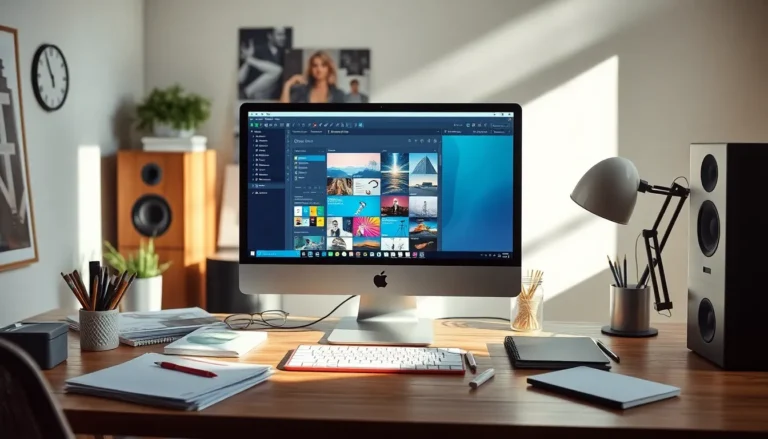As daylight saving time approaches, the age-old question resurfaces: will my iPhone automatically spring forward? It’s a dilemma that can leave even the most tech-savvy among us scratching their heads. After all, who wants to be late for brunch because their phone decided to take a snooze instead of adjusting to the new time?
Table of Contents
ToggleUnderstanding Automatic Time Adjustment
Automatic time adjustment simplifies managing time changes, especially during daylight saving transitions. Users often rely on their devices to handle these changes seamlessly.
What Is Automatic Time Adjustment?
Automatic time adjustment refers to the device’s capability to update its time settings without manual input. Most smartphones, including iPhones, utilize this feature to ensure accuracy. It primarily pertains to daylight saving time changes, reducing the risk of missed appointments. Users benefit from this function since it eliminates the need for constant checking and updates.
How Does It Work on iPhones?
iPhones automatically adjust for daylight saving time using location settings. When enabled, the device compares the current location against a database of time zones. If a user is in an area that observes daylight saving time, the iPhone updates the clock accordingly. Activation of “Set Automatically” in the Date & Time settings ensures this function is operational. Users should confirm their time zone is correct for the iPhone to function properly.
Daylight Saving Time Explained
Daylight saving time (DST) alters clocks to make better use of natural daylight. Most regions in the United States shift clocks forward one hour in spring and back one hour in fall.
The History of Daylight Saving Time
The concept of daylight saving time dates back to World War I. Germany first implemented it in 1916 as a way to conserve energy. Other countries soon followed, using the extra daylight to reduce reliance on artificial lighting. In the United States, DST was first adopted during the same war but became more widespread during World War II. After the war, the practice faced numerous inconsistencies until Congress standardized it in 1966. Since then, many states continue to observe daylight saving time, while a few have opted out.
Why Do We Use Daylight Saving Time?
Implementing daylight saving time aims to maximize daylight usage and conserve energy. Extending evening daylight allows for outdoor activities, reducing the need for artificial lighting during those hours. Research indicates that communities often experience lower energy consumption during DST months. Despite some debate about its effectiveness, many still value the longer daylight in evenings, contributing to increased productivity and leisure opportunities.
Shifting clocks with daylight saving time emphasizes the need for devices like iPhones to accurately reflect these changes, streamlining daily schedules.
Will My iPhone Automatically Spring Forward?
iPhones adjust for daylight saving time automatically, ensuring users don’t miss important appointments. This feature simplifies time management, particularly during transitions when clocks change.
iPhone Settings for Time Adjustment
To enable automatic time adjustment, users must access the Date & Time settings. Activating the “Set Automatically” option is crucial for the device to update its clock. Confirming the correct time zone also enhances accuracy. iPhones use location settings to synchronize time according to regional time zone databases. Ensuring both settings are correctly configured keeps users punctual, reducing the risk of scheduling conflicts.
Common Issues with Time Adjustment
Occasionally, iPhones may struggle to update time settings. Network issues can hinder the device’s ability to access location data. Users sometimes forget to enable the “Set Automatically” option, which leads to incorrect time displays. Traveling across time zones without a manual check might cause clocks to lag or lead. Restarting the phone can resolve minor glitches that affect time accuracy. Troubleshooting these common issues helps maintain the device’s reliability.
Troubleshooting iPhone Time Settings
iPhones typically adjust automatically for daylight saving time, but some users encounter issues. Ensuring the device updates accurately requires a few straightforward steps.
Steps to Ensure Your iPhone Updates Correctly
- Access “Settings” and tap on “General.”
- Select “Date & Time.”
- Activate “Set Automatically” to allow automatic adjustments.
- Confirm your time zone under the “Time Zone” section.
- Verify that the device connects to a reliable network for time updates.
These steps guarantee the iPhone operates with the correct time settings, especially during transitions.
What to Do if Your iPhone Doesn’t Change Time
If the iPhone fails to update the time, several solutions exist. First, restart the device to clear minor software glitches. Next, check the “Set Automatically” option; if it’s disabled, enable it. Additionally, ensure the location services are active, as this allows the device to determine the current time zone accurately. Network connectivity may also affect time updates; verifying a stable connection might help. If issues persist, manually adjusting the time can serve as a temporary fix while troubleshooting continues.
iPhones are designed to automatically adjust for daylight saving time ensuring users stay on schedule. By enabling the “Set Automatically” option and confirming the correct time zone users can take full advantage of this feature. While occasional issues may arise due to network problems or incorrect settings troubleshooting is straightforward.
Understanding how iPhones manage time changes simplifies daily planning and helps avoid the confusion that often accompanies daylight saving transitions. With these tips users can confidently rely on their devices to keep time accurately and enjoy the benefits of extended daylight without the hassle of manual adjustments.



